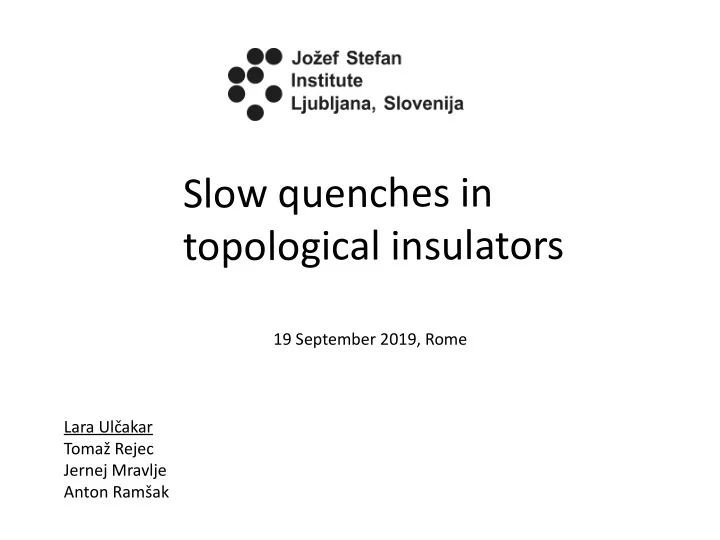

Slow quenches in topological insulators 19 September 2019, Rome Lara Ulčakar Tomaž Rejec Jernej Mravlje Anton Ramšak
Introduction • Quenches in bulk systems • Quenches in systems with edges • Kibble-Zurek mechanism • Quenches in disordered systems • Conclusion • 2
What are topological insulators? Non-interacting systems -> band theory • Bulk: insulator, Fermi energy in the band gap • Edge: conducting states inside the gap. Topologically protected a.k.a. avoid • dissipation. Topological invariant: integer non-local order parameter, property of the • bulk Bulk-boundary correspondence: the number of edge states is related to • the topological invariant 3
Time dependence of topological insulators Quenches between different topological regimes: • Bulk Hall conductivity approaches the new ground-state value Hu, Zoller, Budich, • PRL 117 (2016) Edge states relax towards new ground-state values • Caio, Cooper, Bhaseen, PRL 115 (2015) 4
Systems with time-reversal symmetry – BHZ model Describes low energy physics of quantum wells (2D) • Staggered orbital orbital spin Spin coupling binding energy Topological invariant: 0 or 1 • 4 energy bands: • 5
BHZ model after a quench ● Gap closes, electrons are excited near closing, Landau-Zener dynamics 6
Chern ribbon – QWZ model Staggered orbital orbital binding energy trivial trivial critical topological topological 7
Chern ribbon - excitations 8
Kibble-Zurek mechanism (KZM) Systems driven through a continuous phase transition: • adiabatic adiabatic Freeze-out time: Defect formation! Average defect size: • Density of defects: • 9
KZM – critical exponents of our models is the control parameter • Eq. relaxation time: • W. Chen, J. Phys.: Eq. correlation length: • Condens. Matter 28, (2016) KZM holds! ● 10
Quenches in disordered systems Do quenches create defect domains in real space? ● What would the defects be? ● Disorder breaks translation invariance ● Local Chern marker: ● 11
Conclusion Quenches produce excitations • Power-law scaling of the number of excitations • Transport properties approach new ground-state one values • Kibble-Zurek mechanism connects the power law scaling of defects with • the equilibrium critical exponents Outlook: • – quenches in disordered systems – Are defects formed in real space? – What are the defects? 12
Thank you for your attention! 13
Literature 14
15
16
Recommend
More recommend